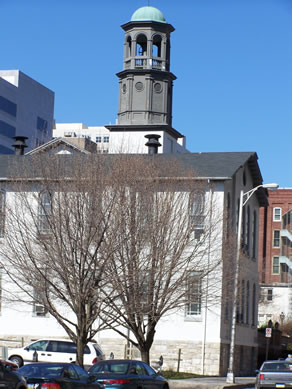Harrisburg on the eve
of Civil War
Study Areas
Salem Church and John Winebrenner
Third and Chestnut Streets, Harrisburg, PA
Salem Reformed congregation was the first congregation in Harrisburg assigned to newly ordained Reformed minister John Winebrenner. The Harrisburg Salem Church was not yet built when Winebrenner arrived in town, and it was largely because of his fundraising and organizing talents that the local congregation was able to construct a new church building at the corner of Third and Chestnut streets in 1822.
There were, however, strong differences of religious opinion and style between John Winebrenner and many in his flock. He was a young, ideological religious scholar, who brought to his post many new ideas regarding how the church should be managed, and he began making decisions that were normally made by the vestry, much to the vestry’s dissatisfaction. He upset his congregants by preaching at Methodist churches, and by inviting non-ordained visitors to preach from his pulpit. Perhaps most upsetting to the highly traditional members of his local church, though, was his revivalist style, with its attendant shouting, noise, and seeming lack of structure.
By April 1823, the Harrisburg church had seen enough of his leadership to advocate for change. Taking matters into their own hands, the church vestrymen locked the doors to Salem Church one Sunday, and when Reverend Winebrenner arrived for services, he found himself locked out, with a large hostile crowd in front of the church on Chestnut Street. Winebrenner took his few loyal followers to the river, and there, in front of John Harris’ grave, he held an outdoor service in his own style. (Link to Harris Grave Site)
When it became apparent that he was not going to be able to wrestle back control of his post, John Winebrenner began holding independent services in various places, including the county courthouse, the market sheds on the square, and in the lumberyards next to the canal, just east of Market Street. A formal church building, called Union Bethel, was constructed on Mulberry Street in 1827, and in 1830, John Winebrenner had himself publicly baptized by immersion in the Susquehanna River by a local Brethren in Christ minister, Jacob Erb. This highly public act followed his numerous successful revivals around the Harrisburg area in the late 1820s, at which he organized the selection of “teaching elders,” who took on a pastoral function.
In October 1831, several of Winebrenner’s teaching elders met in Harrisburg, after agreeing on some basic theological principles the year before, and officially formed the Church of God. This new church was associated with social activism, and embraced such controversial topics as peace, temperance, free education, and anti-slavery. It was also not segregated by race. As a moral reformer, John Winebrenner had earlier been active in distributing religious materials among Harrisburg’s poor, including its African American citizens, and had helped to operate an African American Sunday School. He welcomed African Americans to worship with him at his revival meetings, and his church publicly baptized African Americans. (Above five paragraphs are from George F. Nagle, The Year of Jubilee, Volume One [2010] p. 411-414;)
The church grounds were used to treat wounded Confederate soldiers brought to Harrisburg after the battle of Gettysburg. Historians Lawrence Keener-Farley and James Schmick note that at least two of these soldiers died while being treated at the church, and are buried in Harrisburg Cemetery. (Civil War Harrisburg [2000], p. 5) (Link to article about Civil War soldier burials in Harrisburg Cemetery)
Another nearby building that housed Confederate wounded was the South Ward Colored School, located about one-half block west of this location, at the corner of Cherry Alley and Rasberry Alley. The schoolteacher at that time was John Wolf.
Interesting note: The Reformed congregation acquired Harrisburg's second bell for their church. Forged by Thomas Mears II at Whitechapel Foundry in London, the same makers of the Liberty Bell, the Salem bell was brought to Harrisburg via Philadelphia in May 1822. (Ken Frew, Building Harrisburg [2009] p. 18)
Previous Next
![]()
![]()
All photographs and text on this page copyright © 2010 George F. Nagle and Afrolumens Project.
Notes and Links
Of Interest Nearby



